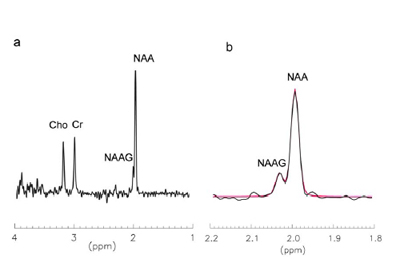Spectral Quantification
This project is aimed to provide more reliable quantitative analysis method for in vivo spectral data, particularly for those weakly represented metabolites such as N-acetyl-aspartyl-glutamate (NAAG). On one hand, new developments of data acquisition method are needed to generate high quality spectral data with increased spectral resolution and reduced interfering signals, e.g. the baseline signals from macromolecules. On the other hand, the methods of data post-processing and spectral fitting are very important as well for quantifying metabolites. We currently put efforts in developing better time domain signal filter to restore distorted spectral lineshape and increase signal-to-noise ratio. Also, we develop software for simulating spin evolution and spectral fitting. With the new method we developed, the weak signal of NAAG can be clearly resolved from the strong background signal of NAA, as shown in Fig. 11.

spectrum. (b) The two Voigt-type peaks (red line) were
fitted to the experimental spectrum from 1.8-2.2 ppm
(black line), yielding the ratio of NAAG to NAA (0.18).
Reference: Yan Zhang, Shizhe Li, Stefano Marenco and Jun Shen. Quantitative Measurement of NAAG at 3 Tesla Using Averaged Echo Time PRESS and Lineshape Deconvolution. Mag. Reson. Med. 2011 Aug;66(2):307-13

